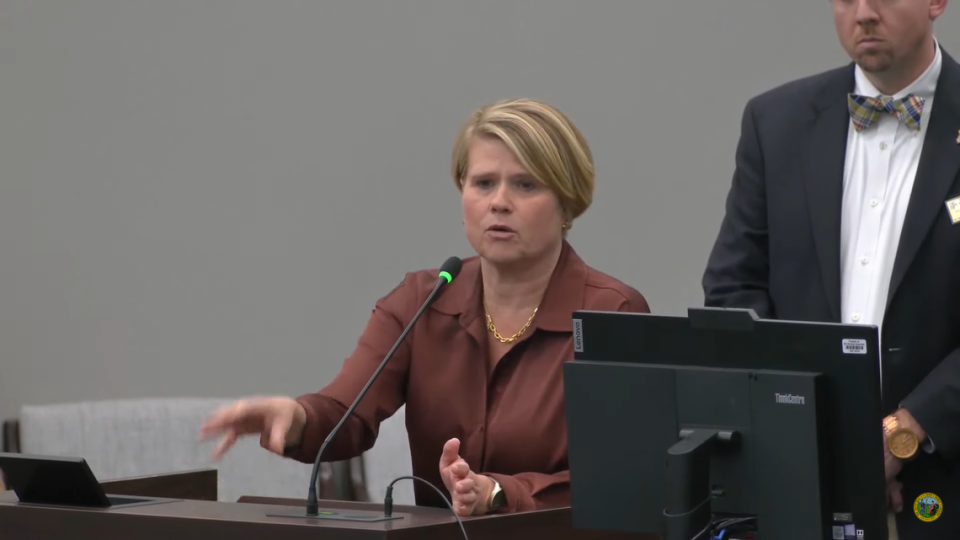Superintendent calls for overhaul in the A to F grades that NC gives its schools
North Carolina could overhaul the way it grades the performance of schools to also rate them based on factors such as student attendance and campus safety.
The state currently gives every public school a single A through F performance grade that’s largely based on passing rates on state exams. But State Superintendent Catherine Truitt wants a new accountability model that would give schools four separate letter grades that would measure everything from test scores to how well students are being prepared for careers.
“Parents don’t understand what the school performance grade means, or how it was calculated,” Truitt told the state House Committee on Education Reform on Monday. “They don’t know what a D actually says about their child’s school, or what an A says about their child’s school.
“So we have an opportunity here to right this ship, to change how we define what a high performing school is and what student success looks like.”
The changes Truitt wants cover how the state grades schools, not the letter grades given to students.
Truitt, a Republican, will need legislative approval to change the accountability model. She’s hoping to get legislation passed this year to begin piloting the program in the fall.
A decade of A-F school grades
State Republican lawmakers passed the A through F school performance grading system into law as part of the 2013 budget. Similar measures have been adopted in other states under Republican control.
The formula in elementary schools and middle schools is based 80% on passing state exams and 20% on growth scores showing how much students have improved. High schools also factor things such as their graduation rate.
Schools with few low-income students are more likely to get higher grades than schools with large numbers of poor children.
Various attempts to change the grading formula have passed in the House but died in the Senate.
Last school year, 35% of the state’s schools received a D or F grade.
Truitt said the state’s current system over identifies low-performing schools. She pointed to a prior state Department of Public Instruction report showing North Carolina has similar national test scores with other states that give fewer D and F grades to their schools.
“We have to do more than simply look at test scores that occur on one day of the year, at the end of the year or the end of the semester,” Truitt told the committee.
New school accountability model
Truitt formed a task force to recommend how to revise the performance model.
Under Truitt’s draft model, schools would get a separate A through F grade in four areas:
▪ Academics (Proficiency rate on state exams)
▪ Progress (Growth scores on state exams)
▪ Readiness (the extent to which schools are preparing students for the post-secondary plans of their choice)
▪ Opportunity (assessment of whether conditions for learning are being met in a school)
*We believe that this provides a more valid depiction of school performance and that it will allow … the department to better use state dollars to assess and support schools in doing a better job of educating our students,” Truitt said. “It will give a clearer picture on what schools are doing to prepare students to be employed, enlisted or enrolled, which is the goal after all.”

Chronic absenteeism
The measurement for readiness would vary by school level. Elementary and middle schools would be measured on how many students are taking career exploration activities. High schools would be held accountable for how many graduates are going to college, the military or the workforce.
Opportunity would include how many students are taking part in intra-curricular and extra-curricular activities, school safety ratings from the N.C. Teacher Working Conditions Survey and the level of chronic absenteeism.
“The statistics on chronic absenteeism are not good,” Assistant State Superintendent Andrew Smith told the committee. “In 2021 and 2022, 31% of North Carolina public school children are chronically absent, missing greater than 10% of the school year. That’s 18 days. It’s almost a full month of instruction.”
That equals a half million children, Smith said.
Pilot new grading system
Truitt wants to pilot the new system this fall with school districts that volunteer to participate. In the second year, Truitt said they’d run both the new and current systems statewide.
But by the third year, Truitt said they’d want to switch to the new grading system.
Lawmakers had plenty of questions Monday about how the new system would work. Among the questions were some skepticism.
“I hope this is not just about making educators and parents feel better rather than having student outcomes actually be better,” said Rep. Hugh Blackwell, a Burke County Republican.
Truitt said the new model will allow DPI to do a better job of helping serve the schools that actually are low performing.
“This is not about changing the 80/20 model to make people feel better,” Truitt responded to Blackwell. “I would say what this does more than anything is it exposes the fault lines in schools in a way that the current model doesn’t.
“And it allows the legislature and the department to know how to go in and support the people in the building — whose salaries make up 83% of school funding — and say, here’s what you need to do to be better.”
Staff writer Avi Bajpal contributed to this report.


